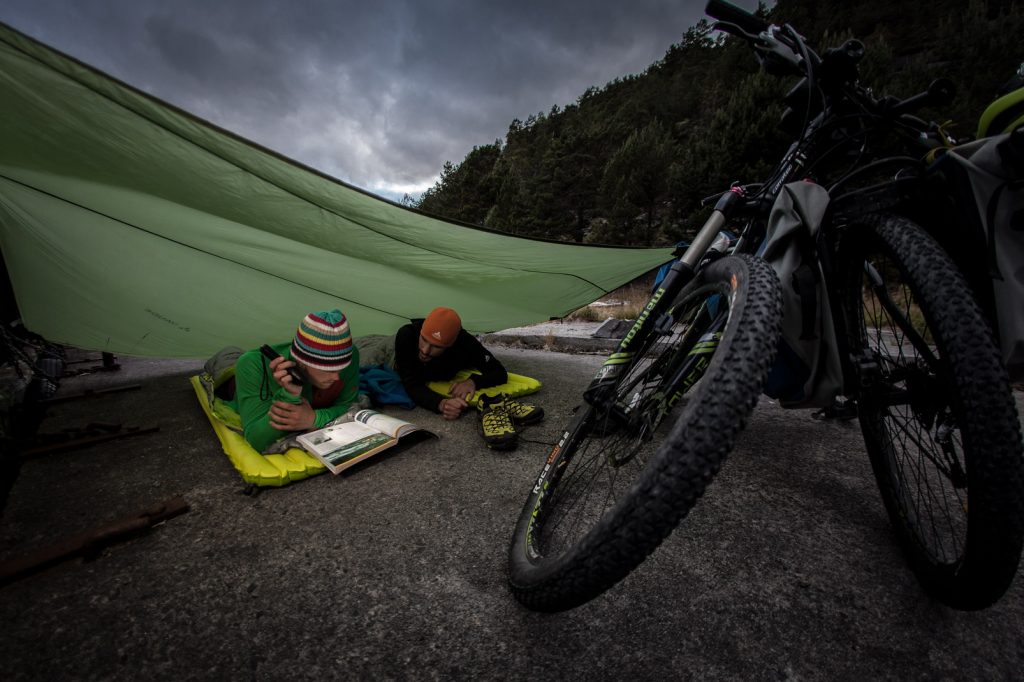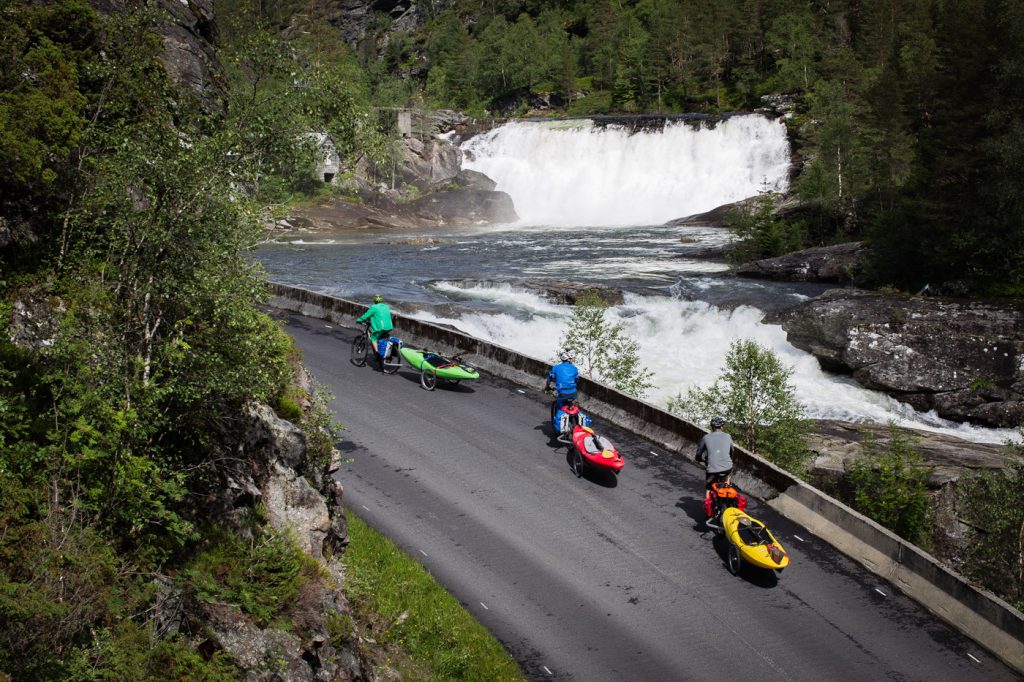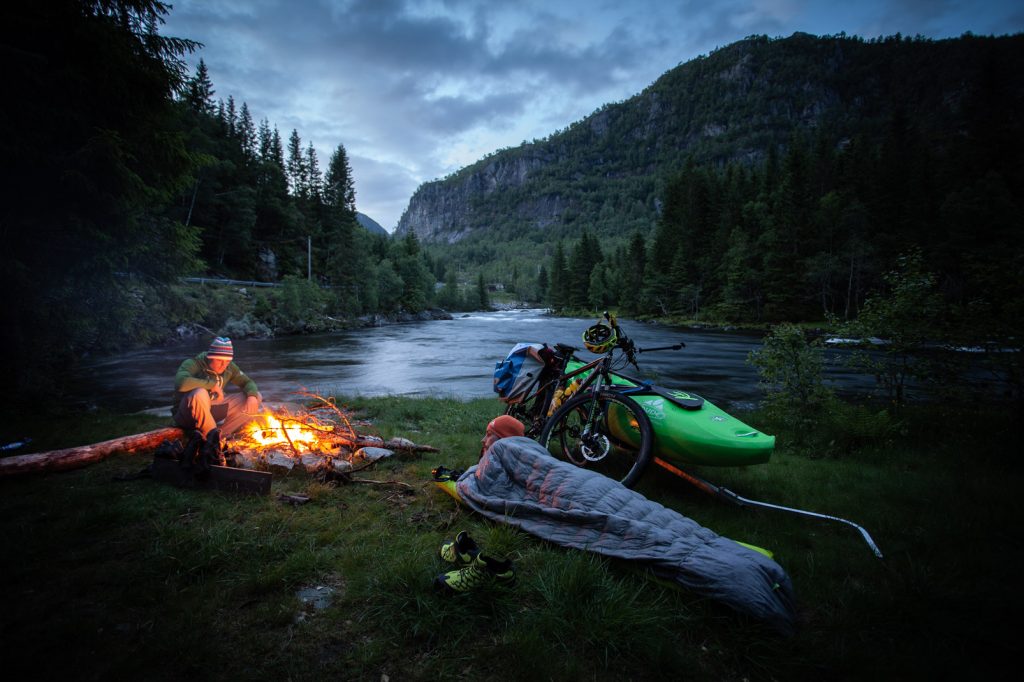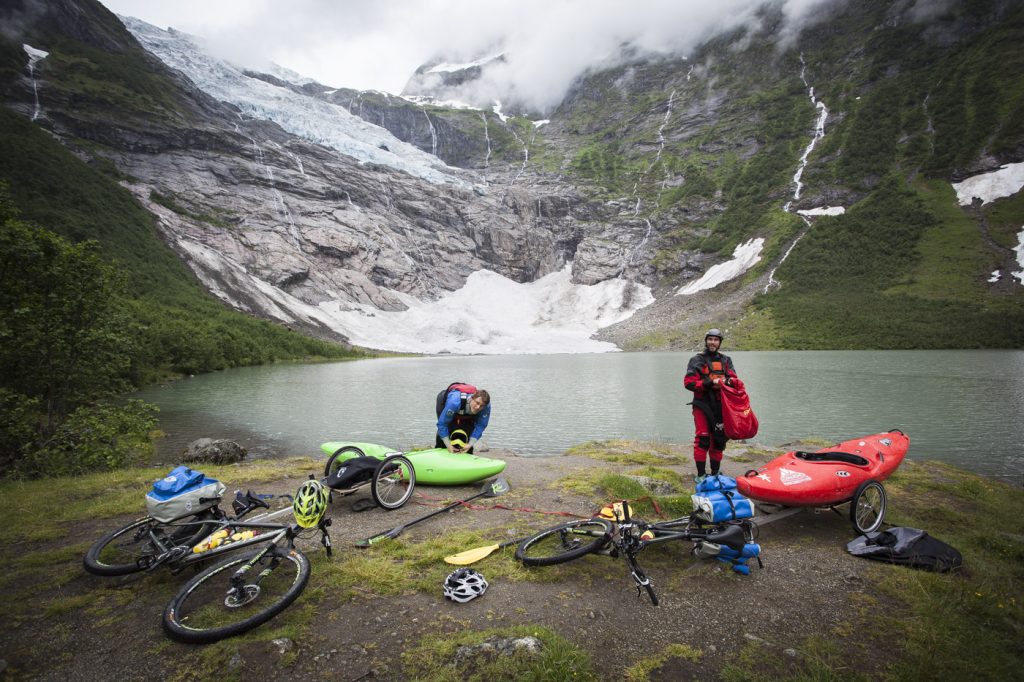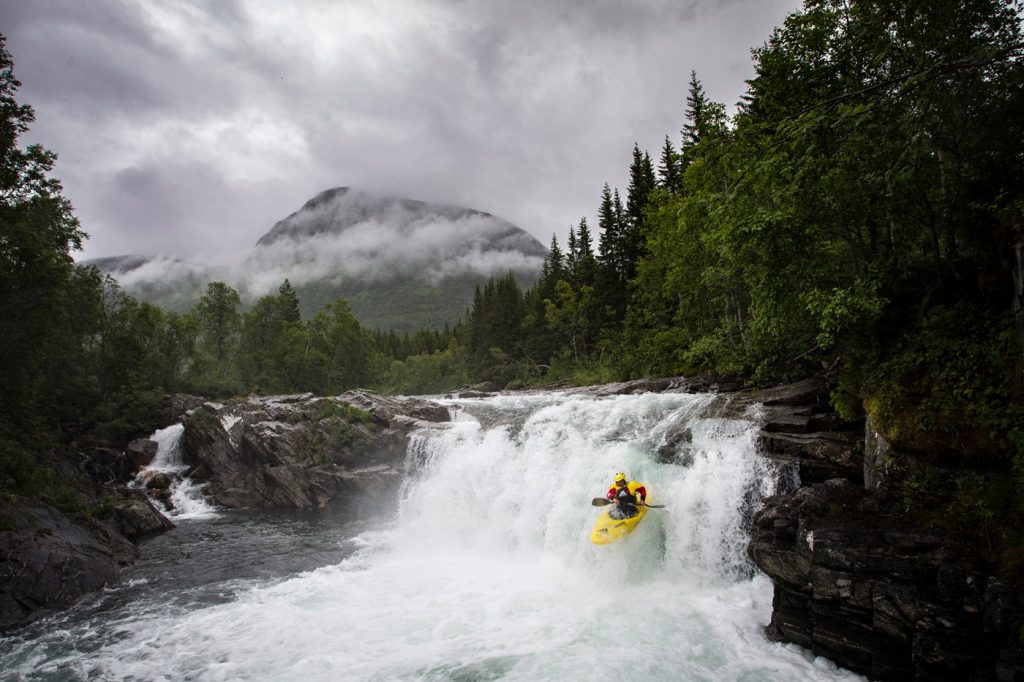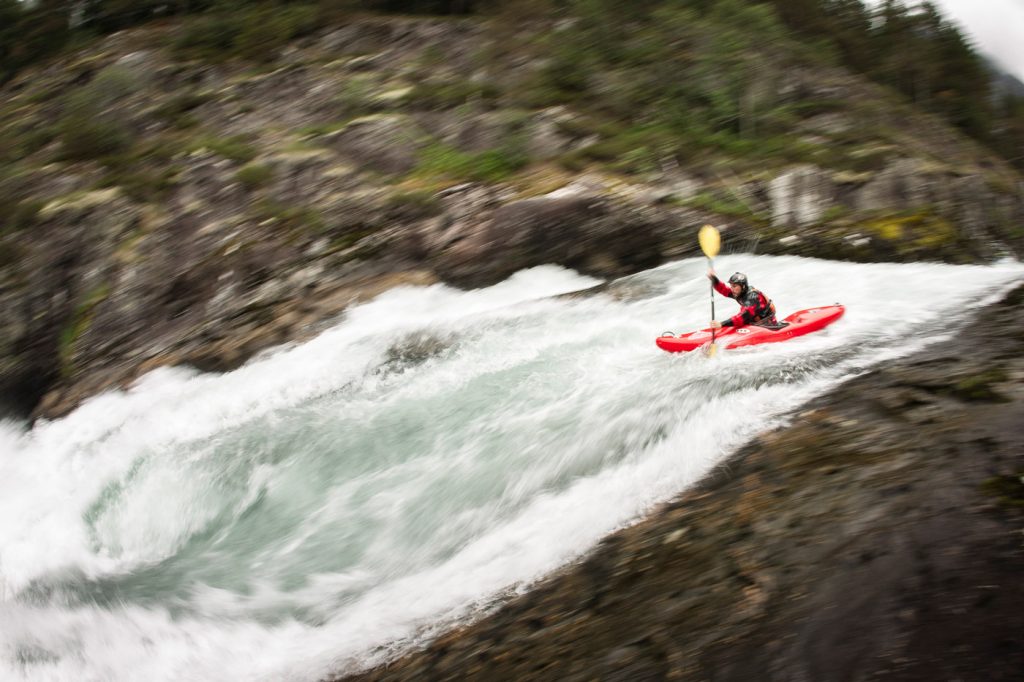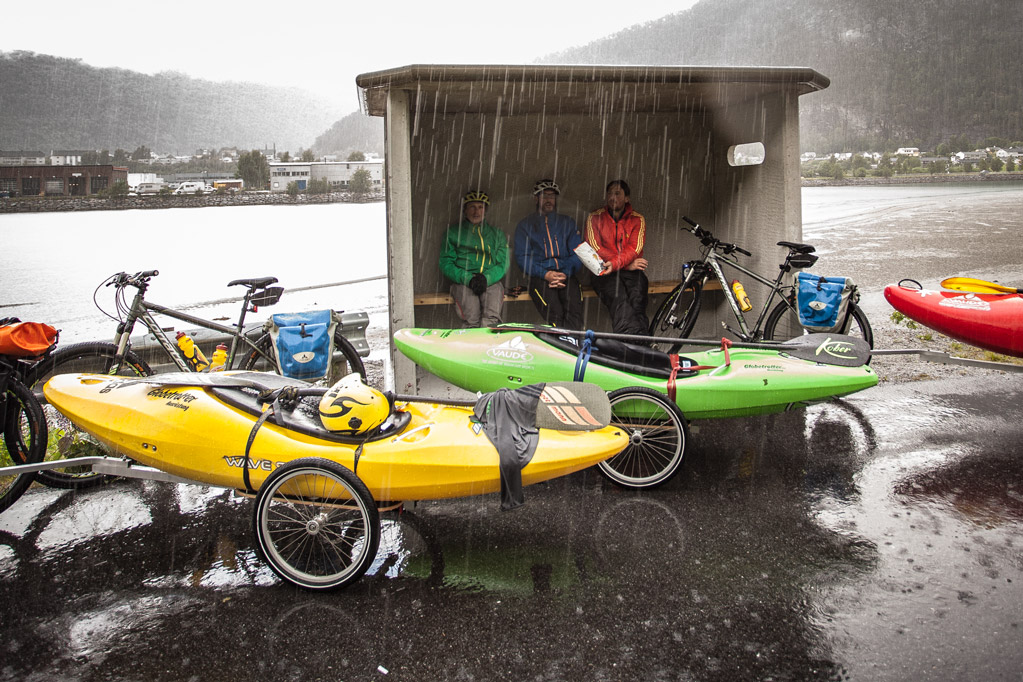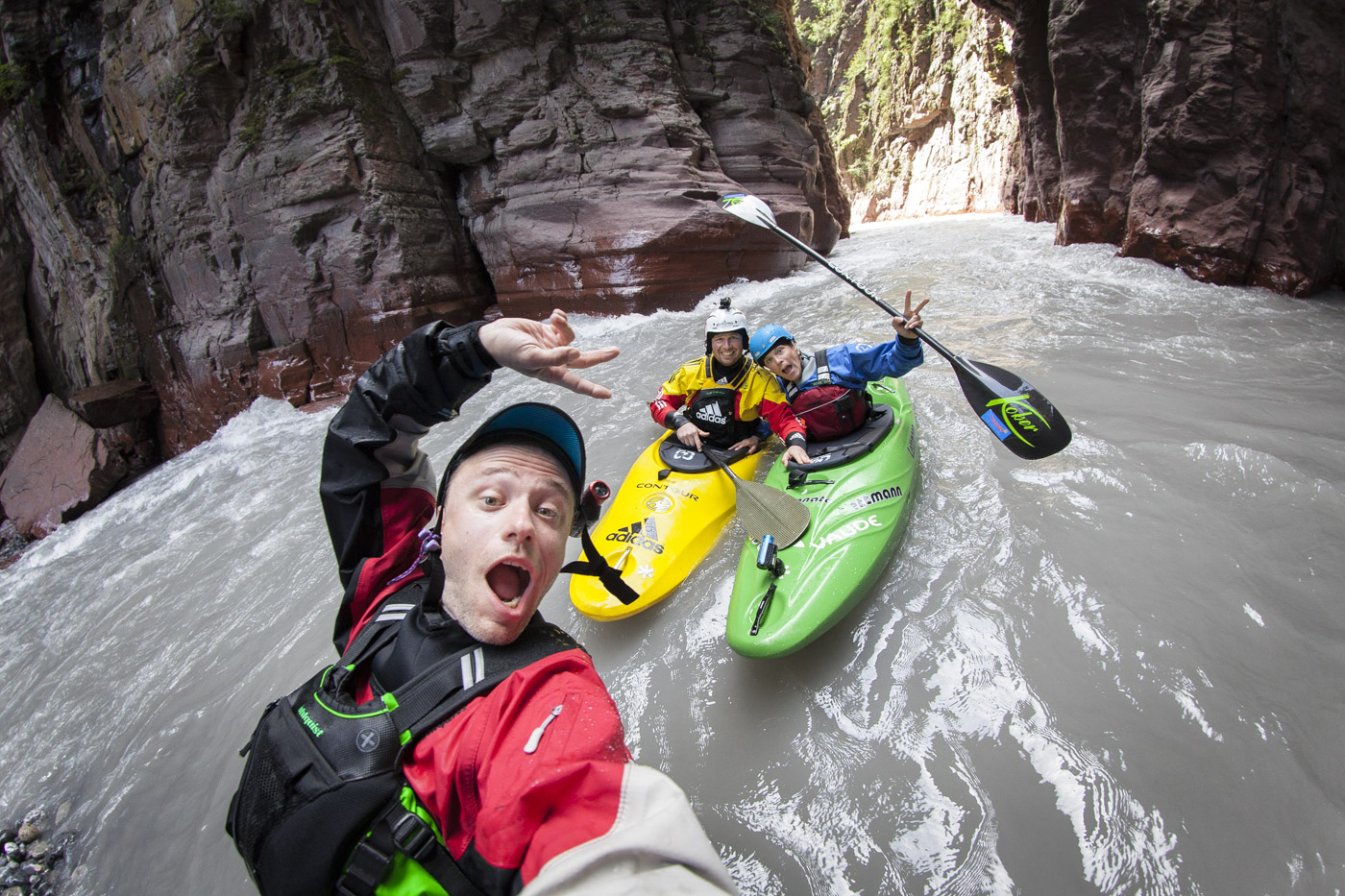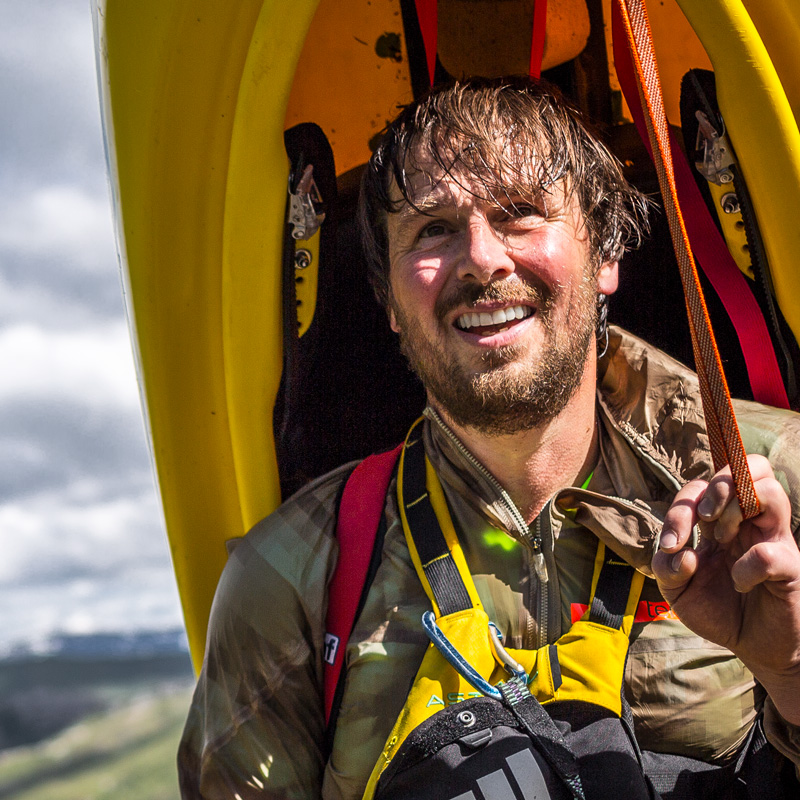The land of fjords and waterfalls
Norway is considered one of the best places in the world for whitewater kayaking. In July 2012, Olaf Obsommer, Lukas Wielatt and Philip Baues set off to tow their kayaks by bike for 600 km through Fjordland, paddling hard-earned rivers along the way.
Words: Philip Baues – Photos: Jens Klatt
The deafening blare of a horn shakes me out of my sleep. With a groan I open my eyes and stare dumbfounded at a huge cruise liner moving over the water only a stone’s throw away. I lie on the floor in my sleeping bag, freezing and wishing to sink back into my dream world. But where the hell am I? And how did I end up here? There are old life vests and paddling jackets hanging on the wall, some ratty sprayskirts lie in a corner, and on the wooden floor I spot an empty bottle of Vodka, cod-liver oil, some burnt down candles… and a strange guy in a tracksuit top and patent leather shoes. I rub my eyes in disbelief. “WTF?!”
Slowly last night’s memories come back. After taking a late ferry to the Geirangerfjord on the west coast of Norway, we decided to spend the night at a campground nearby. Getting there with the kayaks and all the equipment packed on the trailer, we made a bit of a sensation – nobody had seen crazy guys like us before. The owner of the campsite was so impressed that he invited us to a local’s night in the bar next door. This is where things got out of control, and somehow Luke and I ended up in an old boat shack together with a Russian captain and said bottle of Vodka.
Suddenly I hear a soft whimpering from a corner. Lukas is also struggling with the combination of hard liquor and cod-liver oil. When I ask him why we had to be into the grog just before the queen’s stage up the Geiranger Pass, he has a simple answer: “Because it would have been impolite to refuse that invitation.” That’s a good point. I guess. After a little hangover breakfast, we get back in the saddle to tackle the 600 steep uphill meters of Geiranger Pass. Even if we can hardly fit our heads under the helmets, the last few weeks on the bike pay off: slowly but steadily we climb up the switchbacks and are rewarded with breathtaking views over the fjord and the surrounding mountains.
Why Bike2Boat?
After having travelled the world with our kayaks leaving huge ecological footprints, we began to ask ourselves if it would be possible to do such a project by more sustainable means. But could we make it without a car? Would our legs carry us to put-ins and take outs, and up and over the passes from river to river? Would we have the patience to travel at such a slow pace with so much whitewater on hand? We wanted to find out. We wanted to know what it would feel like to earn the rivers we’d paddle, and we looked forward to escaping the rush of every day life. As compensation for traveling slowly, we knew we would be better able to soak up scenery and experiences along the way.
On July 1st in the city of Bergen, with high hopes and fresh legs, we load our kayaks on bike trailers instead of a roof rack. Tent, sleeping bag, stove, food and equipment was stuffed in panniers, the kayaking gear in the boats on the trailers. Ahead of us lies a 600-kilometer route up hill and down dale, past glaciers and coves, through valleys and fjords, from river to river.
The route would lead us from Bergen through the fjord region north to Åndalsnes. In the run-up to the trip we had made a fairly detailed plan of where we wanted to be at what time, so we had a timeline with the days of traveling and the rivers we wanted to paddle. Of course, we would have to depart from that plan here and there due to water levels, delays in cycling or just bad weather. One thing was for sure: we had three and a half weeks to get ourselves and our kayaks to the finish line in Åndalsnes, with only our legs to take us there.
Barely an hour into the first day however, Lukas and I already have reason for doubt. Still within the Bergen city limits, Olaf flips his trailer and only just avoids a serious fall. Moments later we gasp up the first climb, cursing the force of gravity. Fifty kilograms of equipment act like an anchor on the back of our bikes, and our legs quickly grow weak. Olaf dismisses our doubts: “Boys, you only grow with the challenge!” Bitterly I ask him if he plans a career in clichés, but then I silently continue pedaling.
facts
Route:
From Bergen to Andelsnas
Time:
3 weeeks, July 2012
Length:
600 km
Team:
Olaf Obsommer, Lukas Wielatt,
Philip Baues, Jens Klatt

If you eat fish, you’re gonna swim!
After a day and a half in the saddle, we are getting used to the exertion. We climb the hills in bottom gear and on the downhills Luke and I try to catch up with big boy Olaf. He insists his higher downhill speed results from superior skills and not simply from his superior body weight. During the breaks we reload with PowerBars and bread with the much-loved fish paste. As the sun rises on the second day, so does the anticipation to take our first paddling strokes.
In the Eksingdalen, Luke and I swap our cycling gear for neoprene, helmet and life jacket for the first time. A nice 10-meter-waterfall begs for a run. I’m ecstatic, but before long I come back down to earth with a bang. I paddle to the horizon line, set the angle of my kayak with a measured last stroke and enjoy the feeling of free falling. But right after the plunge I find myself being dragged backwards, straight into the curtain of exploding water. I have no choice but to leave my boat. I fight against the backwash, failing to get free again and again. As I am almost ready to give up, I finally wash free. Gasping, I lie on shore and watch my kayak go down the next rapid. Great start to the kayaking part of the trip: Paddle five meters, and then swim a hundred! Luckily we are able to rescue both paddle and boat – otherwise it would have been the end of kayaking in Norway for me. And I should have known better. My roommate, slalom paddler Fabian Dörfler, often warned me “If you eat fish, you’re gonna swim!”
It’s just a quick storm!
In the next few days, I get a lot of chances to get back in the game. Our first big destination is Voss, known as the whitewater capital of Norway and hosting city of the annual Ekstremsportveko, where crowds of kayakers, mountain bikers, skiers, base jumpers, paragliders, skaters and climbers gather for a week full of competitions, parties and concerts.
The rivers around Voss are simply amazing. No matter if you are looking for big water or steep creeks, for park ’n’ huck or remote gorges – everything is right at your fingertips, accessible within half an hour of driving. By car, of course. We, however, have to work hard on the bike for every meter of paddling. But we are earning a lot of quality whitewater: Moneydrop, Morning Glory and Doubledrop are all names that make kayakers cock their ears.
What’s dampening the mood is the weather. If you are going to Norway, you’d better not expect just sunshine and roses, but this year seems to be particularly wet. Everyone is feeling sorry for us because of the beastly weather. In the beginning, I try to keep my spirits up. “It’s just a quick storm – it’ll blow over!” I always shout when it starts to rain cats and dogs again. But eventually I have to admit these downpours have a lot of staying power up here in the north. It rains every day. But equally often the sun shows up. If the glass is half-full or half-empty is just a matter of perspective.
»When you are already exhausted before you put on the sprayskirt, the Norwegian whitewater feels even more intimidating than normal. We enjoy every single minute in our kayaks, as the descents are the well-deserved pay-off after arduous work on our bikes.«
Philip Baues
»The best run of my season«
Whatever the weather is like, except for three rest days, we are on our bikes every day. Sometimes it’s only a couple of kilometers to the next river, on other days we cycle more than 80 kilometers to get to the next region. The daily routine is often the same: get up, eat, pack up, bike, eat, bike, paddle, eat, pitch the tent, eat more and go to bed.
Indeed you think a lot about food while sitting on the bike for many hours. For us however there was no opulent meal in store after biking, only the next athletic challenge on the river. When you are already exhausted before you put on the sprayskirt, the Norwegian whitewater feels even more intimidating than normal. Concentration, good decision-making, and efficient paddling are more essential than ever. We enjoy every single minute in our kayaks, as the descents are the well-deserved pay-off after arduous work on our bikes.
In the next days and weeks we are travel through the fjordland, enjoying rivers, roads, rests, and as much food as we could eat. Slowly coming to an end, this trip comes up with yet another treat. On the shores of Norddalsfjorden we find a beautiful camp, and to make things even better, some young local anglers give us freshly caught fish for dinner. Delicious, it also provides us energy for our next day’s ride to the Stordalselva, one of the most eagerly anticipated river runs on the trip.
Olaf has assured us we will discover a true gem if the water level is right, and getting to the put-in after a long bike ride we run into Benji Hjort, Jakub Sedivy and Toni George. The gauge is high but good and we jump in our boats. And indeed, that river delivered what Olaf had promised: continuous whitewater, tricky waterfalls, and a few must-run rapids, all in a spectacular valley. After only 300 meters, the walls of the first gorge start to close in and a clean 6-meter waterfall awaits. The next double stager requires precise moves before the canyon begins to opens up. From here, most drops and rapids can be walked if paddlers aren’t feeling on. All of us enjoy the numerous big and little moves as we continue downstream. At the take-out, Benji announces that this has been his best run so far of the season. If you know Benji and how much he kayaks, you’ll have an idea of how great the Stordalselva is.
»In the end, it is all the little moments off the beaten path that we will most remember: the pure joy in having a dry shelter for the night, the whooping screams of the usually rather reticent locals, the pleased feeling of having reached another goal at the end of the day.«
Philip Baues
Discovering tranquility
Our trip leads us past some of the most popular and beautiful nature attractions of Norway. The Sognefjord stretches 205 kilometers inland, making it the largest fjord in Norway and the second longest in the world. At the foot of Europe’s biggest glacier, the Jostedalsbreen, tourists are in for a surprise as we launch into the ice-cold water for a scenic lake paddle. An impressive boat cruise through Geirangerfjord and the climb up the Trollstigen are more of the many highlights of our journey. Yet, in the end, it is all the little moments off the beaten path that we will most remember: The pure joy in having a dry shelter for the night, the whooping screams of the usually rather reticent locals, the pleased feeling of having reached another goal at the end of the day.
Traveling by bike we experience Norway and its people in a totally different way. While landscapes rush by the car windscreen, from the cyclist’s point of view they change slowly and comprehensibly. We have ample time to take in our surroundings – uphill sometimes more than we want.
As if Norway wants to dare us one last time, the Trollstigen rises in front of us on our final stage to Åndalsnes. Again, we face some hundreds of meters in altitude; again it is cold and wet. On top of the pass, for a moment, I am not sure if it’s still raining or already snowing. Like bees around a honeypot we head for the dry and warm restaurant for a big piece of cake before we start off downhill. While we are racing down the switchbacks, I realize that Olaf is not flying past us as he did early in the tour. He must have lost his superior technique. Or he just didn’t have enough cake. <<<


